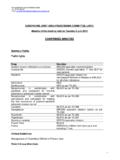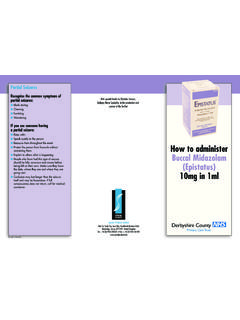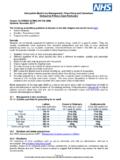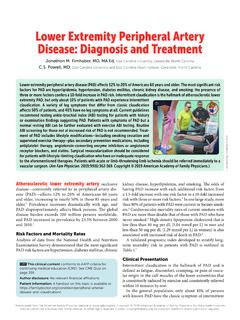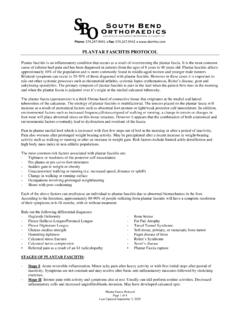Transcription of Guidelines for the use of Compression Hosiery
1 Guidelines for the use of Compression Hosiery First produced: May 2014 Reviewed: September 2021 Next Review date: August 2024 Page 1 of 6 Guidelines FOR THE USE OF Compression Hosiery Do not routinely include made to measure on the prescription. Made to measure should only be selected if the patient has had their leg measurements checked in the past six months and none of the standard sizes are appropriate. If in doubt discuss with the community pharmacist or community nurse. To avoid confusion Hosiery can be prescribed as generic Compression Hosiery class 1 below knee. Compression Hosiery is palliative not curative and treatment should continue for as long as there is evidence of venous disease in most cases this is life-long (exc.)
2 Pregnancy) Compression Hosiery should not be applied if there is a history or presentation of symptomatic peripheral arterial disease (PAD) (see assessment criteria). In the absence of any of the risk factors in the assessment criteria it is safe to start with Compression Hosiery up to 20mmHg, which is defined as mild graduated Compression . The Ankle Brachial Pressure Index (ABPI) test should be used as guide to assess the presence of significant PAD but should only be an adjunct to clinical assessment. For patients requiring higher than 20mmHg Compression Hosiery to treat moderate/severe oedema, ABPI is required. Consider the use of a milder Compression whilst waiting for the Doppler assessment to avoid deterioration of condition if appropriate and dependant on the results of a thorough assessment.
3 An ABPI is also recommended if starting with Class 3 support stockings. All patients with chronic venous leg ulcers should have a lower limb assessment performed prior to treatment. Arterial insufficiency should be investigated further by the vascular team to ensure adequate circulation if clinically appropriate. The recommended degree of Compression depends on the condition being treated. If the person cannot tolerate the preferred Compression for their condition, try the next level down (NICE CKS) Ideally, lower limb assessments should be repeated every 6 12 months or earlier if clinically indicated (NICE CKS) Patients treated with Compression Hosiery should be reviewed every 6 months (with repeat lower limb assessment if appropriate) to reassess the condition for disease deterioration and to ensure the person is continuing to wear the stocking correctly and successfully.
4 Compression Hosiery for the sole prevention of deep vein thrombosis (DVT) for travellers is not available on NHS prescription and patients should be advised to purchase class 1 below knee stockings or proprietary flight socks . DERBYSHIRE JOINT AREA PRESCRIBING COMMITTEE (JAPC) Guidelines for the use of Compression Hosiery First produced: May 2014 Reviewed: September 2021 Next Review date: August 2024 Page 2 of 6 INTRODUCTION Graduated Compression Hosiery is used to provide Compression and support in conditions related to venous insufficiency or oedema. It exerts the greatest degree of Compression at the ankle, and the level of Compression gradually decreases up the garment.
5 Graduated Compression Hosiery is palliative rather than curative, and their use needs to continue for as long as there is evidence for venous disease . Patients should be informed that it is likely that Compression will be required indefinitely. ASSESSMENT Compression Hosiery should not be applied if there is a history or presentation of symptomatic peripheral arterial disease (PAD). Before prescribing, the patient should be assessed for the following:- Acute infection of the leg/foot (increasing unilateral redness, swelling, pain, heat) Symptoms of sepsis Acute or chronic limb threatening ischaemia Suspected acute DVT Suspected skin cancer Painful cramping in calf muscles during activity or climbing stairs (intermittent claudication) Leg numbness or weakness Cold leg and/or foot, especially when compared with the other side Absent or difficult to feel foot pulse Poor capillary refill (should be less than 2 seconds) Drop in pulse oximetry on leg elevation (NWCSP 2020)
6 If any one or more of these is present, arterial insufficiency should be excluded by measuring the ABPI using a Doppler machine, performed by a suitably trained and competent healthcare professional. All patients with chronic venous leg ulcers should have a lower limb assessment performed prior to treatment which may include an ABPI using a Doppler ultrasound. Dependant on the arterial-brachial pressure index: ABPI Comments Less than Severe arterial disease is likely. Compression stockings should not be worn. Between * Arterial disease is likely. No more than light (class 1) Compression should be applied. Close monitoring is advised after Compression is commenced.
7 (if there are specific concerns seek specialist advice from Tissue Viability / Vascular Service). Between Compression stockings are safe to wear. Greater than May suggest the presence of atrial calcification, such as in some people with diabetes, rheumatoid arthritis, systemic vasculaitus atherosclerotic disease and advanced chronic renal failure. Care must be taken in interpreting ABPI in people with these conditions as they may be misleadingly high, this is very common, especially in patients with diabetes. If there are no signs / symptoms of PAD, a raised ABPI in isolation does NOT automatically preclude the use of Compression Hosiery .
8 Consider seeking further advice from community specialist team / Vascular Service. Note *The ABPI tool for diagnosis is a reasonable guide as to the presence of significant peripheral arterial disease (PAD) but should only be an adjunct to clinical assessment. An easily found palpable foot pulse (found with fingers, not a doppler probe) indicates Compression can be used without the need of referral. However, the level of Compression must be in line with national and local guidance and taking into consideration the overall clinical assessment. It is also important to check the condition of the skin. Fragile skin may be damaged while trying to put on or take off Compression stockings.
9 Ideally, venous ulcers should be healed before using Compression stockings. Be aware that if worn incorrectly, Compression stocking may cause local pressure on toes or over malleoli, leading to skin necrosis, especially in diabetics. The above is guidance only and should not replace clinical judgement. Guidelines for the use of Compression Hosiery First produced: May 2014 Reviewed: September 2021 Next Review date: August 2024 Page 3 of 6 Do not offer anti-embolism stockings to people who have: Suspected or proven peripheral arterial disease (PAD) Peripheral arterial bypass grafting Peripheral neuropathy or other causes of sensory impairment Any local conditions in which anti-embolism stockings may cause damage for example, fragile 'tissue paper' skin, dermatitis, gangrene or recent skin graft Known allergy to material of manufacture Severe leg oedema Major limb deformity or unusual leg size or shape preventing correct fit (NICE NG89, 2018) TYPES AND INDICATIONS British Standard Drug Tariff Classification elastic Hosiery (BS 6612) and RAL/European classification are both available on FP10.
10 Three classes are available, with differing levels of Compression at the ankle and differing indications for use. British Class (BS6612:1985) Compression at the ankle Class 1* (Light (Mild) Support) 14-17 mmHg Class 2 Medium (Moderate) Support 18-24 mmHg Class 3 Strong support 25-35 mmHg * Liners (10mmHg) may be an option for patients unable to tolerate class 1 stockings to start with working on the assumption that some Compression is better than none. Liners can be layered to provide higher levels of Compression (for example a double layer liner stockings amount to class 2 stockings (20mmHg) and some patients may prefer this option) NB: Liners from Hosiery kits can be higher than 10mmHg, always check manufacturers guidance.
